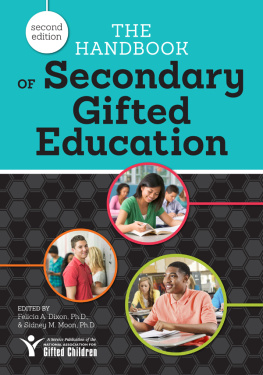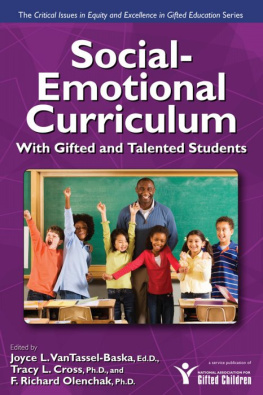

Copyright 2015 Prufrock Press Inc.
Edited by Rachel Taliaferro
Cover and layout design by Allegra Denbo
ISBN-13: 978-1-61821-278-8
No part of this book may be reproduced, translated, stored in a retrieval system, or transmitted, in any form or by any means, electronic, mechanical, photocopying, microfilming, recording, or otherwise, without written permission from the publisher.
At the time of this books publication, all facts and figures cited are the most current available. All telephone numbers, addresses, and websites URLs are accurate and active. All publications, organizations, websites, and other resources exist as described in the book, and all have been verified. The authors and Prufrock Press Inc. make no warranty or guarantee concerning the information and materials given out by organizations or content found at websites, and we are not responsible for any changes that occur after this books publication. If you find an error, please contact Prufrock Press Inc.

| Prufrock Press Inc.
P.O. Box 8813
Waco, TX 76714-8813
Phone: (800) 998-2208
Fax: (800) 240-0333
http://www.prufrock.com |
Dedication
For John Feldhusen, our mentor, whose research in and advocacy for secondary gifted education provided inspiration for our work in this volume.
And for our families: David, Diane, Adam, Olivia, and Madeline; Deirdre, Jamey, Jada, and Dane (Felicia); and Richard, Joan (now deceased), Doug, Alex, Jeff (now deceased), Mark, Trudie, Caroline, Reid, Rob, Sue, and Brianne (Sidney), who encouraged us in this endeavor and continue to remind us of why gifted education is important throughout life.
Table of Contents
Felecia A. Dixon & Sidney M. Moon
Introduction
The Handbook of Secondary Gifted Education (2nd ed.) is a collaboration of researchers and practitioners who have written chapters on issues related to gifted adolescents in secondary schools. It is the right time for this second edition. Although secondary gifted education is not at the forefront of current federal educational legislation, time does not freeze, and the need for high-ability, talented, and creative students to step up and change the landscape of our nation by offering new ways of viewing issues and situations is crucial. Although schools in the United States now have flexibility within the law to pursue comprehensive plans to improve educational outcomes for all students, to close achievement gaps, and to improve the quality of teaching within schools, we still need to offer more to our best and brightest. We continue to get mired in accountability issues, which impact secondary gifted students because they are held back in the process.
In the first edition, our introduction focused on agendas including the No Child Left Behind Act (2001); the publication of the Templeton National Report on Acceleration (Colangelo, Assouline, & Gross, 2004), which asserted that schools hold back their brightest students, allowing their educational progress to be determined by the pace of their less able peers; and Davidson, Davidson, and Vanderkams (2004) book, Genius Denied, which stated that American students lagged behind students in other industrial nations, while the brightest learn to coast through school, seldom stretching their brains. Indeed, the picture presented of gifted education at the secondary level was dismal then and hasnt improved much since. We still are woefully behind other nations on national competitive tests, and we are witnessing a flight of the creative class (Florida, 2007) in which our brightest students are enticed to take their creativity to other countries.
Currently, President Obamas Race to the Top initiative offers incentives for states to structure schools to pursue higher standards, improve teacher effectiveness, use data effectively in the classroom, and adopt new strategies and interventions to help the lowest performing, struggling schools. The impact of these agendas is minimal for gifted secondary adolescents. However, high-ability secondary students do fare better in the presidents initiative to improve STEM offerings in high schools. The Obama administration has promoted STEM initiatives, including prioritizing STEM education in Race to the Top and the Investing in Innovation Fund; improving the coordination of STEM education initiatives between the Department of Education and the National Science Foundation (NSF); and promoting over 100 industry partners in their efforts to boost STEM learning through Change the Equation (see http://changetheequation.org/). Additionally, the presidents High School Redesign initiative challenges high schools and their partners to rethink teaching and learning and put in place learning models that are rigorous, relevant, and better focused on real-world experiences (see http://www.ed.gov/highschool). However, there are very few specifics supplied for how this initiative meets the needs of high-ability adolescents. Certainly these efforts are needed, but are they enough?
In reflecting on the provisions for high-ability secondary students that are available nationally, we must also consider four important questions that Finn and Hockett (2012) ask concerning the education of high-ability students:
1.Is the United States providing all of its young people the education that they need in order to make the most of their capacities, both for their own sake and for that of the larger society?
2.Have we neglected to raise the ceiling while weve struggled to lift the floor?
3.Is America making wise investments in its own future prosperity and security by ensuring that its high-potential children are well prepared to break new ground and assume leadership roles on multiple fronts?
)
These are essential questions for high-ability students at the secondary level. There are other questions that we need to ask as well. How will the Common Core State Standards (CCSS) impact gifted adolescents? According to the National Association for Gifted Children (NAGC; 2014), Although the new content standards are considered to be more rigorous than most current state standards, they fall short in meeting the specific needs of gifted learners, and if held strictly to the standard, could actually limit learning. To overcome this pitfall, it is imperative that gifted educators create a full range of supports for high-ability learners through differentiated curriculum, instruction, and assessments (para. 4). Additionally, what do we do about 21st-century skills, a current buzzword in education? Although we know that our students are technologically savvy and can understand and use current technology in appropriate contexts, and we know that our curriculum for the gifted secondary student includes critical and creative thinking skills, we may need to do a better job of incorporating more collaborative experiences and activities as we teach in order to prepare our students for team environments as they advance in their chosen careers.
The Handbook of Secondary Gifted Education (2nd ed.) is divided into five parts. in the second edition differs from the first edition in that it totally focuses on the content disciplines. We have added both a technology and an engineering chapter in order to address all four disciplines included in STEM.

















